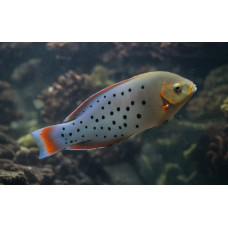Latin name
Coris formosa
Other name
Sand wrasse, Queen coris wrasse, Formosan coris, Formosa coris wrasse, Formosa wrasse, Indian Ocean wrasse or Indian sand wrasse.
Identification
Queen Coris are similar in appearance to Coris gaimard.
Their colouration is thought to depend on the depth at which they are found, but the differences are mainly due to differences between the juvenile and adult growth stages. Colour is the most important feature of Coris formosa as it is used for display, to attract potential mates and in fighting relationships between males. Fish have small protruding teeth for feeding (mainly on organisms with hard shells).
Features of fish fins
The queen coris has nine dorsal spines, twelve dorsal soft rays and three anal spines.
Fish colouring
The colour usually varies within three different shades. In general it tends to be reddish or lavender. At maturity, the fish appears blue-greenish with dark edges and dark blue spots covering the body (mostly towards the tail), with a red-orange line along the trailing edge towards the tail. It has light blue organic lines. When young, queen coris are orange-brown underneath, with long white spots on the dorsal part of the body. There is a resemblance to the colouration of clownfish. However, as adults they develop bright blue features.
Distribution
Queen corals are found in the western Indian Ocean, the southern Red Sea, South Africa and as far east as Sri Lanka.
Habitat
Adults of this species inhabit non-rhythmic oceanic coral reefs and are found at depths of 2 to 50 m (6.6 to 164.0 ft). They inhabit tropical waters with temperatures between 24°C and 27°C. While juveniles are usually found in low tide areas, adults are usually found in rocky and coral areas, sometimes among vegetation.
Size
The queen coris is 20 cm long when young, but can grow to around 60 cm.
Behavior
A very aggressive species as they are dominant, especially the males during the mating season. Their aggression is mainly territorial. They can be a threat to smaller fish and are very efficient invertebrate hunters. In the aquarium it has a habit of shifting sand and rocks and tends to burrow into the sandy substrate. Burrowing can serve a number of purposes. These include reproduction, as the fish may lay eggs under the sand for protection. Another potential use of burrowing could be to find food (most of the queen coris prey is found in the sand). Burrowing into soft ground to sleep or make a home is also a possible reason for this behaviour. The queen coris is a solitary fish that can be very aggressive in captivity, especially when it gets very large. This species requires a lot of space to swim and in captivity tends to hide under the sand during acclimatisation. When adults become too large to be kept in an aquarium, they tend to hide in small crevices between coral or rocks.
Food and feeding habits
They feed on hard-shelled prey such as crustaceans (shrimps, crabs and amphipods) and echinoderms (sea urchins and small molluscs). When they develop teeth, they become very efficient hard-shelled predators and can become very aggressive and destructive. Juveniles feed mainly on other smaller organisms, such as krill, until they are able to prey on hard-shelled organisms.
Reproduction
An oviparous species, meaning that the female produces her offspring from eggs. It is an ancestral fish, a semi-hermaphrodite. Semi-hermaphrodites can change sex from female to male. In this case, the female's reproductive organs develop earlier than the male's, and in most cases, populations consist mainly of females. However, when a male is needed, one of the females will become a male for reproductive purposes. This is known as polygamy, or different mating behaviour during reproduction. As a result, males are dominant and are usually responsible for a large harem or several harems, especially during breeding. This situation can occur even though Coris is a solitary species. Males are thought to pursue females by swimming close to them and waving their fins.
Fishing
This species is of secondary importance to the local commercial fishery.
Relationship with a person
Harmless. Queen Coris can be found in the aquarium trade due to their bright colouring.
| Classification | |
| Phylum | Chordata |
| Class | Actinopterygii |
| Squad | Labriformes |
| Family | Labridae |
| Genus | Coris |
| Species | C. formosa |
| Features | |
| Conservation status | Least Concern |
| Habitat | Pelagic |
| Life span, years | No information |
| Maximum body weight, kg | No information |
| Maximum length, cm | 60 |
| Sailing speed, m/s | No information |
| Threat to people | Edible |
| Way of eating | Predator |
Queen coris
Tags: queen coris

